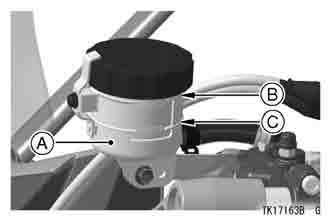 Kawasaki Z1000SX - Owner's Manual > Brakes
Kawasaki Z1000SX - Owner's Manual > Brakes
Brake Wear Inspection
Inspect the brakes for wear. For each front and rear disc brake caliper, if the thickness of either pad is less than 1 mm (0.04 in.), replace both pads in the caliper as a set. Pad replacement should be done by an authorized Kawasaki dealer.

- Lining Thickness
- 1 mm (0.04 in.)
Brake Fluid
In accordance with the Periodic Maintenance Chart, inspect the brake fluid level in both the front and rear brake fluid reservoirs and change the brake fluid. The brake fluid should also be changed if it becomes contaminated with dirt or water.
Fluid Requirement
Use heavy-duty brake fluid only from a container marked DOT4.
NOTICE Do not spill brake fluid onto any painted surface.
Do not use fluid from a container that has been left open or that has been unsealed for a long time.
Check for fluid leakage around the fittings.
Check brake hose for damage.
Fluid Level Inspection
- With the brake fluid reservoirs held horizontal, the brake fluid level must be kept between the upper and lower level lines.

- Front Brake Fluid Reservoir
- Upper Level Line
- Lower Level Line

- Rear Brake Fluid Reservoir
- Upper Level Line
- Lower Level Line
- If the fluid level in either reservoir is lower than the lower level line, check for fluid leaks in the brake lines, and fill the reservoir to the upper level line.
WARNING Mixing brands and types of brake fluid can reduce the brake system's effectiveness and cause an accident resulting in injury or death. Do not mix two brands of brake fluid. Change the brake fluid in the brake line completely if the brake fluid must be refilled but the type and brand of the brake fluid that is already in the reservoir are unidentified.
NOTE
- First, tighten until slight resistance is felt, which indicates that the cap is seated on the reservoir body, and tighten the cap an additional 1/6 turn while holding the brake fluid reservoir body.

- Reservoir
- Cap
- Clockwise
- 1/6 turn
Fluid Change
Have the brake fluid changed by an authorized Kawasaki dealer.
Front and Rear Brakes -
Disc and disc pad wear is automatically compensated for and has no effect on the brake lever or pedal action.
So there are no parts that require adjustment on the front and rear brakes.
WARNING Air in the brake lines diminish braking performance and can cause an accident resulting in injury or death. If the brake lever or pedal feels mushy when it is applied, there might be air in the brake lines or the brake may be defective. Have the brake checked immediately by an authorized Kawasaki dealer.
Brake Light Switches
When either the front or rear brake is applied, the brake light goes on. The front brake light switch requires no adjustment, but the rear brake light switch should be adjusted in accordance with the Periodic Maintenance Chart.
Inspection
- Turn the ignition key to ON.
- The brake light should go on when the front brake is applied.
- If it does not, ask an authorized Kawasaki dealer to inspect the front brake light switch.
- Check the operation of the rear brake light switch by depressing the brake pedal. The brake light should go on after the proper pedal travel.

- Brake Pedal
- 10 mm (0.4 in.)
- If it does not, adjust the rear brake light switch.
Brake Pedal Travel

Adjustment
- Remove the right front footpeg bracket bolts.
- Pull the footpeg bracket a little bit outward.

- Bolts
- Right Front Footpeg Bracket
- To adjust the rear brake light switch, move the switch up or down by turning the adjusting nut.

- Rear Brake Light Switch
- Adjusting Nut
- Lights sooner
- Lights later
NOTICE To avoid damaging the electrical connections inside the switch, be sure that the switch body does not turn during adjustment.
- Reinstall the right front footpeg bracket.
Tightening Torque

NOTE
- If a torque wrench is not available, this item should be serviced by a Kawasaki dealer.
See also:
 Kawasaki Z1000SX - Owner's Manual > Drive Chain
Kawasaki Z1000SX - Owner's Manual > Drive Chain
The drive chain slack and lubrication must be checked each day before riding the motorcycle and must be maintained in accordance with the Periodic Maintenance Chart for safety and to prevent excessive wear. If the chain becomes badly worn or maladjusted - either too loose or too tight - the chain could jump off the sprockets or break.
 Kawasaki Z1000SX - Owner's Manual > Front Fork
Kawasaki Z1000SX - Owner's Manual > Front Fork
The front fork operation and oil leakage should be checked in accordance with the Periodic Maintenance Chart. For various riding or load conditions the front fork can be adjusted for Spring preload, Rebound damping force and Compression damping force.
 Rider's Manual BMW R 1250 GS GSA
Rider's Manual BMW R 1250 GS GSA Owner's Manual Harley-Davidson Sportster XL1200X Forty-Eight
Owner's Manual Harley-Davidson Sportster XL1200X Forty-Eight Owner's Manual Honda CBR650R
Owner's Manual Honda CBR650R Service manual Honda CBR650
Service manual Honda CBR650 Owner's Manual Honda PCX125
Owner's Manual Honda PCX125 Owner's Manual Kawasaki Z1000SX
Owner's Manual Kawasaki Z1000SX Service manual Kawasaki Z1000SX
Service manual Kawasaki Z1000SX Owner's Manual Lexmoto Echo
Owner's Manual Lexmoto Echo Owner's Manual Royal Enfield Interceptor 650
Owner's Manual Royal Enfield Interceptor 650 Service manual Royal Enfield Interceptor 650
Service manual Royal Enfield Interceptor 650 Owner's Manual Yamaha MT-07
Owner's Manual Yamaha MT-07